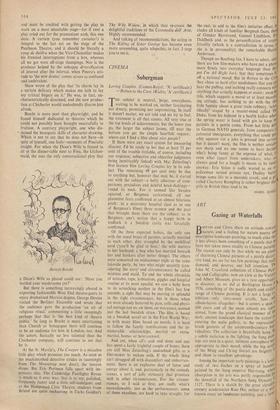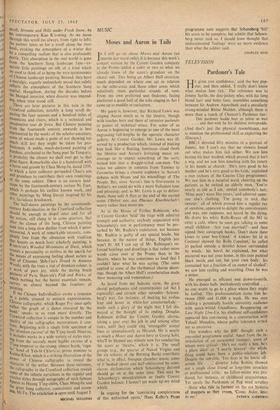ART
Gazing at Waterfalls
RITA IN and China share an attitude toward' nDoature, and a feeling for nature poetry and , descriptive landscape painting, so much alike 110 it has always been something of a puzzle that 01 have not taken more readily to Chinese painting' The reason can only be that•while we see pleoli of charming Chinese pictures of a purely decotx 'live kind, we see far too few paintings that realb' demand, and deserve, our full attention. The John M. Crawford collection of Chinese Pain' ing and Calligraphy, now on view at the Victoria and Albert Museum, gives us a rare opportuniU to discover, as we did at Burlington House in 1936, something of the poetic depth and stylisi1C range 'of Chinese painting. It is not a large ea' hibition—only sixty-seven scrolls, fans tine ( album-leaves altogether—but it covers a span of 600 years and all the main schools are rerle; sented, from the grand classical manner of , dark, ancient landscape that faces the visitor on entering the main gallery, to the expressionls, brush gestures of the seventeenth-century Inds, vidualists. The collection is beautifully hung. n a subtle variation in the lighting, the Sung pail ings are seen in a quiet, intimate atmosphere ve, appropriate to their mood, while the big scrol'',1 of the Ming and Ch'ing literati are brightly II and show to excellent advantage. Among the important early paintings is a lacli study of two finches on a spray of bamboo; painted by the Sung emperor Hui-tsung, absorption in the arts was partly responsible i; the downfall of the Northern Sung Dynasty 1127. There is a sketch by the great eleverlii century academician Kuo Hsi, author of a wet known essay on landscape painting, and a hallj, scroll, Streams and Hills under Fresh Snow, by his contemporary Kao K'o-ming. As we move through this scroll (as always, from right to left), the painter takes us for a stroll along the river bank, evoking the atmosphere of a winter day by a compelling realism that is also profoundly Poetic. This absorption in the real world is gone from the Southern Sung landscape fans—ex- quisite little paintings on silk of a kind which We used to think of as being the very quintessence of Chinese landscape painting. Instead, they have a nostalgic, vaguely melancholy mood that subtly reflects the atmosphere of the Southern Sung capital, Hangchow, during the decades before the Mongol invasion, when disaster was impend- ing, when time stood still.
There are later pictures in this vein in the Crawford collection, notably a long scroll de- picting the four seasons and a hundred miles of mountains and rivers, which is a technical and imaginative tour de force. But Chinese painting from the fourteenth century onwards is best represented by the works of the scholar-amateurs, some of whom made a point of not showing too Much skill lest they might be taken for pro- fessionals. A noble, much-darkened painting of bamboo, attributed to the Sung poet Su Tung-p'o, is Probably the closest we shall ever get to that great figure. Remarkable also is a handscroll with a horse and groom by Chao Meng-fu, dated 1359, to Which a later collector persuaded Chao's son and grandson to contribute their own renderings of the same subject. There is an austere land- scape by the fourteenth-century recluse Ni Tsan, which is perhaps his earliest known work, and other paintings by Ming literati inspired by his dry, fastidious brushwork. The half-dozen paintings by the seventeenth- century Individualists in the Crawford collection should be enough to dispel once and for all the notion, still clung to in some quarters, that after the climax of the Sung, Chinese painting sank into a long slow decline from which it never recovered. A work of remarkable intensity, com- Pletely free from the obsession with tradition that haunts so much later scholarly painting, is 1('un-ts'an's Wooded Mountains at Dusk, which the a personality as restless in the search for `tile means of expressing feeling about nature as that of Cdzanne. Shih-t'ao's Drunk in Autumn PI nods, with the trees a riot of drunken colour, is a work of pure joy, while the daring brush gestures of Pa-ta Shan-jen's Fish and Rocks, of Which nothing but the barest essentials remain, carries us almost beyond the frontiers of Painting. If the Chinese Individualists evoke a response in a public attuned to western expressionism, Chinese calligraphy, which Roger Fry once aptly called 'the graph of a dance executed by the hand,' speaks to us even more directly. The Crawford collection is unique in the number and Quality of the calligraphic masterpieces it con- theBeginning. with a single little specimen of drunken cursive' of the T'ang monk Huai-su, n includes works in a wide variety of styles vary- i from the scarcely more legible cursive of a Tang emperor to the strong, almost harsh, 'regu- lar' hand of Yeh-lij Ch'u-ts'ai, prime minister to Nubia; Khan, which is a striking illustration of the Power of Chinese calligraphy to reveal the character bf the writer. Between these extremes, Inc calligraphy in the Crawford collection reveals some of the infinite variations in the regular and cursive styles through autographs of such famous figures as Huang T'ing-chien, Chao Meng-fu and the great Sung collector, connoisseur and eccen- ._
Mi Fu. The exhibition is open until August 1.
MICHAEL SULLIVAN















































 Previous page
Previous page